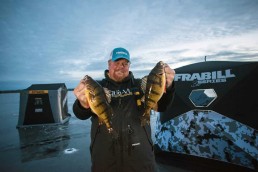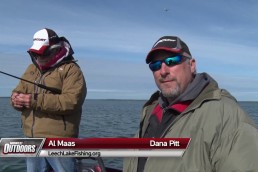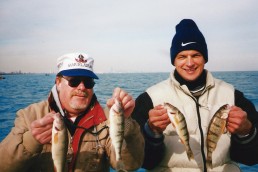Targeting February Jumbo Perch on Leech Lake
SHARE THIS POST
One of the best perch lakes in Minnesota is Leech Lake, with its many bays, plentiful forage and wide variety of both shallow and deep habitat.
Leech Lake is not only great for perch. The wide variety of habitat here provides great fishing for walleyes, muskies, northern pike, large and smallmouth bass, crappies, sunfish and even whitefish and eelpout.
Leech is a gem, no matter what time of the year or what species. Perch are one of the most prolific species in the lake, with many anglers fishing for walleyes during prime time in the mornings and evenings and then fishing for perch during daylight, when the walleye fishing slows down.
Perch are capable of living in many environments, as long as they can find a suitable food source. A healthy population of perch provides food for just about everything else in the lake, with plenty of perch left over for anglers to harvest.
Most good perch lakes have decent growth rates, with the species reaching a harvestable size of 8 to 9 inches around year seven of their growth cycle. The best perch lakes usually have several age-classes of harvestable perch at any one time and seldom have large gaps between age-classes.
These fish will travel in huge schools during the winter if food is plentiful and concentrated into specific areas. If the forage is more scattered, the perch will likely break down into smaller groups as they search for food. In winter, locate and pattern these fish. Once a few “keeper-sized” perch are caught, the odds of success go way up because you are usually close to a good school of perch if you can fine-tune your location.
Schools are usually split between two or more patterns during the winter: The majority of the perch are often using one main pattern, with the rest split between one or more other patterns.
Food is usually the key factor in their location, regardless of season. Whatever food source is most abundant and easiest will usually attract the most perch. Insects, minnows or freshwater shrimp are all viable food sources during the winter. Crayfish are almost always a preferred food source for big perch, so the largest may be doing something different than the rest of the perch population. The bulk of this fish’s population in Leech is late in the winter, usually relating to the chara-covered weed flats that are so prevalent in the large shallow bays. If there are perch in deep water, they are usually in 20 feet and close to the drop-off, rather than in 30 feet or more beyond like they can be in many other lakes in winter.
Shallow perch are usually feeding on minnows, crayfish and a few insects, while in deep water they feed on insects, like mayfly larvae or bloodworms. Perch are opportunistic feeders and seldom feed on just one thing—they usually have a main course and then supplement their diet with whatever else they can find.
The shallow flats on Leech Lake are often covered with chara, which is a hard-stemmed weed that stays green all year long. Chara does not have roots, so it gets blown around the bottom by waves during the summer and collects in mats like underwater tumble weeds. Chara beds are full of insects, crayfish and can hide minnows and smaller fish, so the schools of perch swim over the top of these beds and hunt for anything they can find.
Are you enjoying this post?
You can be among the first to get the latest info on where to go, what to use and how to use it!
When the perch are actively feeding, they can be pretty easy to catch and almost anything will work. The tricky part is catching them when they are being finicky, so it takes some extra finesse to coax them into biting. When deep-water perch are inactive, they often lay so tight to the bottom that their bellies are actually touching it. I can still see the separation between the perch and the bottom when I zoom in on the bottom with my underwater camera.
If I need to see the area with my own eyes, or want to watch the fish when they take my bait in shallow water, I have an AquaVu Micro 5 rigged right with my sonar so I can down-view at the same time I am fishing.
Downsizing is usually the key when perch are tough to catch. Sometimes I will go all the way down to a 1/16-ounce Northland Forage Fry Spoon with a 3-pound-test fluorocarbon “Bro-Dropper” to catch the perch if that’s what it takes.
I will usually use a 1/64-ounce Northland Tungsten Fireball Jig on the “Bro-Dropper” tipped with as little as a single maggot or half of a waxworm in some situations.
Another go-to presentation for tough-biting perch is to use a Frabill Bro-Series “Dead-Stick” with the new “Bro-Band” rigged with 3-pound-test mono and a Northland Mud Bug tipped with a single waxworm or 1 to 3 euro larvae.
I like to pound the Mud Bug into the bottom and then set the rod on a bucket to hold it still with the lure set about an inch from the bottom. I watch the rod tip for a little “bump” knowing that the line will release from the Bro-Band if a fish hits the bait too hard.
Shallow-water perch are usually more active and more willing to bite than those in deeper water. I like to use a flutter spoon tipped with a minnow head and let it shoot out to the side of the hole when it drops, and then walk it back into the center of the hole, which is deadly on perch.
If the shallow perch get a little tougher to catch, I usually have a rod rigged with a Northland Helium Fly and tipped with a couple of euro larvae or a waxworm. The Helium Fly drops much slower than tungsten lures and has that floating action that can be so deadly on perch and other gamefish species.
Leech Lake is spread out over 120,000 acres, so there are many access points. It has become one of the true destination areas in northern Minnesota with dozens of resorts catering to anglers and visitors during every season.
MWO
SHARE THIS POST
Did you enjoy this post?
You can be among the first to get the latest info on where to go, what to use and how to use it!
Brian 'Bro' Brosdahl
Outdoor communicator Brian “Bro” Brosdahl lives in northern Minnesota. He is a walleye guide in the Cass Lake, Leech Lake and Lake Winnibigoshish areas. He is sponsored by Northland Fishing Tackle, Frabill/Plano, Aqua-Vu, Humminbird/Minn Kota, St. Croix Rods, Ranger Boats, and Evinrude. Guide inquiries: brosguideservice.com. Follow on social media.



